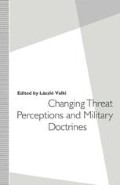Abstract
The new centrality of Europe and especially of Germany seems to have resulted from the rapid breakdown of the ‘Eastern subsystem’, or rather the composite Soviet empire that contributed in 1945 to the marginalisation of the old continent and to the bipolar division of the world.
Access this chapter
Tax calculation will be finalised at checkout
Purchases are for personal use only
Preview
Unable to display preview. Download preview PDF.
Notes and References
Not by chance, even the book by Paul Johnson (A History of the Modern World from 1917 to the 1980s, London: Weidenfeld & Nicolson, 1983)
It is true that between the two world wars (1919–39) the phenomenon of ‘de-Europization’ of the international system seemed to have stopped. Nevertheless, the balance of power mechanism, which had functioned so harmoniously for almost three centuries between 1648 and 1914, began to show its age early on. See Edward V. Gulick, Europe’s Classical Balance of Power (Ithaka, NY: Cornell University Press, 1967)
Edward H. Carr, The 20 Years Crisis: 1919–1939 (London: Macmillan, 1978).
See Norman Rich, Hitler’s War Aims (New York: Norton, 1973)
Andreas Hillgruber, Hitler’s Strategic (Munich: Bernard & Graefe, 1986)
Robert E. Herzstein, When Nazi Dreams Come True (London: Abacus, 1982).
The concept of Mitteleuropa has undergone many changes not only in geographic breadth of the defined area, but also in the interpretation of the role of the Central empires, and of Germany in particular. ‘Almost all tend to at least comprise the area between the Rhine basin to the West, the Danube to the South, and the Vistula to the East. But there are also those definitions that include Burgundy, the Vosges regions, Italy, Dalmatia, Flanders, Denmark, and the Scandinavian countries.’ See Henry C. Meyer, Mitteleuropa in German Thought and Action, 1815–1945 (The Hague: Nijhoff, 1955)
Jacques Droz, L’Europe Centrale: Evolution historique de l’idée de ‘Mitteleuropa’ (Paris: Payot, 1960).
David A. Baldwin, ‘Power Analysis and World Politics: New Trends Versus Old Tendencies’, World Politics, vol. 31 (1970), pp. 161–94
See the essay by Nancy Kanwisher, ‘Cognitive Heuristic and American Security Policy’, Journal of Conflict Resolution, vol. 33 (1989) pp. 652–75.
George Liska, Nations in Alliance (Baltimore: Johns Hopkins University Press, 1963)
Glenn H. Snyder, ‘The Security Dilemma in Alliance Politics’, World Politics, vol. 31 (1984) pp. 461–95
Stephen M. Walt, The Origins of Alliances, (Ithaca, NY: Cornell University Press, 1987).
Jack S. Levy, War in the Modern Great Power System, 1495–1975, (Lexington: University Press of Kentucky, 1983)
Paul Kennedy, The Rise and Fall of the Great Powers (New York: Random House, 1987)
George Modelski and William R. Thompson, Seapower in Global Politics, 1494–1993 (Seattle: University of Washington Press, 1988)
Joshua S. Goldstein, Long Cycles, (New Haven: Yale University Press, 1988).
On the number of essential actors in the various systems, see the pioneering work by Morton A. Kaplan, System and Process in International Politics (Reading: Addison-Wesley, 1957).
For a definition, see Carlo Maria Santoro, Il sistema di guerra (Milan: F. Angeli, 1988).
See D. P. Rapkin, W. R. Thompson, J. A. Christopherson, ‘Bipolarity and Bipolarization in the Cold War Era: Conceptualization, Measurement and Validation’, Journal of Conflict Resolution, vol. 23 (1979) pp. 261–95).
Michael W. Doyle, Empires (Princeton: Princeton University Press, 1986) pp. 123–38.
Karl W. Deutsch, The Analysis of International Relations (Englewood Cliffs: Prentice Hall, 1978).
See Karl Popper, The Poverty of Historicism, (London: Routledge & Kegan Paul, 1957).
George Mosse, Masses and Men (New York: Fertig, 1980).
See Carles Tilly (Ed.), The Formation of National States in Western Europe (Princeton: Princeton University Press, 1975).
Harold D. Lasswell and Abraham Kaplan, Power and Society (New Haven: Yale University Press, 1950).
J. David Singer, ‘Inter-Nation Influence: A Formal Model’, American Political Science Review, vol. 57, (1963) pp. 420–32
Jan F. Triska (Ed.), Dominant Powers and Subordinate States (Durham: Duke University Press, 1986).
Hélène Carrère d’Encausse, L’empire éclaté (Paris: Flammarion, 1978)
Viktor Zaslavsky, ‘Gorbachev’s Perestroika and Soviet Nationality Policy’, Quadern Papers, no. 16 (Milan: ISPI, 1989)
Consider Italy in the Mediterranean as an example of this need. See Carlo Maria Santoro (1990), L’anfibio tricolore, ovvero la politica ester a di una Media Potenza, (Bologna: Il Mulino).
The major theories on nationalism include the’ strong’ ones based on the idea that nationalism is the expression of the nation, and the ‘weak’ ones which, one way or another, connect it to the concept of national identity. See Anthony D. Smith, Theories of Nationalism (New York: Harper Row, 1971).
John Breuilly, Nationalism and the State (Chicago: University of Chicago Press, 1983) p. 302.
G. H. N. Seton-Watson, Nations and States (London: Methuen, 1977).
Anthony D. Smith, The Ethnic Revival, (Cambridge: Cambridge University Press, 1981)
A. L. Epstein, Ethos and Identity (London: Tavistock, 1978)
Seweryn Bialer, Stalin’s Successors (Cambridge: Cambridge University Press, 1980) p. 207.
On the ideal link between Russian nationalism and Soviet Bolshevism, see Mikhail Agursky, The Third Rome: National Bolshevism in the USSR (Boulder: Westview Press, 1987)
Alexander Yanov, The Russian New Right (Berkeley: California University Press, 1978) pp. 29–30
John B. Dunlop, The Faces of Contemporary Russian Nationalism (Princeton: Princeton University Press, 1983).
Mark N. Katz, ‘The Decline of Soviet Power’, Survival, vol. 32 (1990) pp. 15–28
Graham H. Turbiville Jr, ‘Restructuring the Soviet Ground Forces’, Military Review, vol. 69, (1989) pp. 17–30.
Editor information
Editors and Affiliations
Copyright information
© 1992 László Valki
About this chapter
Cite this chapter
Santoro, C.M. (1992). Nationalism in Europe: Trends and Threats. In: Valki, L. (eds) Changing Threat Perceptions and Military Doctrines. Palgrave Macmillan, London. https://doi.org/10.1007/978-1-349-12060-4_9
Download citation
DOI: https://doi.org/10.1007/978-1-349-12060-4_9
Publisher Name: Palgrave Macmillan, London
Print ISBN: 978-1-349-12062-8
Online ISBN: 978-1-349-12060-4
eBook Packages: Palgrave Political & Intern. Studies CollectionPolitical Science and International Studies (R0)

